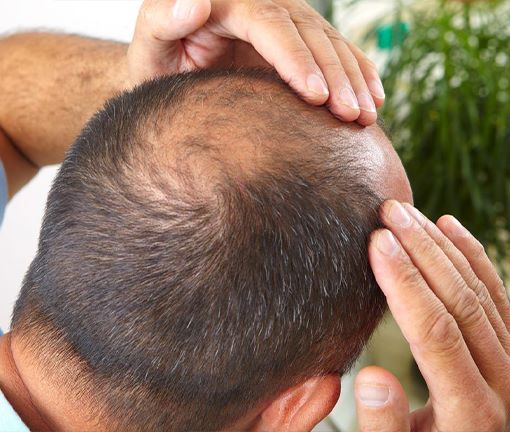What is Crown Hair Loss and Available Treatment Options

Have you ever noticed folks dealing with hair saying their goodbyes? Balding is like that unexpected friend who overstays. Now, let’s zoom into a specific chapter – Crown Hair Loss. Imagine a remarkable circle of hair vanishing from the top of your head. But no worries! We’re diving into the mystery of Crown Hair Loss and checking out simple solutions. It’s like a journey to reclaim your hair kingdom. So, hang on as we explore how to bring back the glory with easy treatments for your crown’s royal comeback.
What is Crown Hair Loss?
Crown Hair Loss is a distinct pattern of hair thinning at the crown or crown balding characterized by forming a circular or oval-shaped area at the top of the scalp. It commonly affects both men and women, manifesting differently in each gender. In men, the condition often results in a noticeable bald spot at the back of the head, while in women, it leads to generalized thinning in the vertex region. This pattern is attributed to genetic predisposition, hormonal fluctuations, and aging.
Symptoms and Identification of Hair Thinning at the Crown
Identifying hair thinning at the crown involves keen observation of specific symptoms that manifest gradually.
- Widening Part Line: Notice if your hair part is getting wider, especially at the top. This widening is a sign of potential crown hair thinning.
- Circular or Oval Balding Area: Look for the emergence of a distinct circle or oval-shaped area on the scalp. This localized thinning is a characteristic feature of crown hair loss.
- Reduced Hair Density: Feel the thickness of your hair. Crown thinning often reduces hair density, making individual strands appear finer and less robust.
- Visible Scalp: As the condition progresses, the scalp in the crown area hair loss becomes more visible, resembling a bald spot.
- Miniaturized Hairs: Check for finer hairs in the crown region. Miniaturization occurs as hair follicles shrink, a common trait associated with genetic factors and hormonal imbalances.
- Changes in Texture: Observe any shifts in the texture of your hair. Crown thinning may result in hair becoming more fragile and prone to breakage.
- Slower Regrowth: A slower regrowth of hair in the crown could indicate a prolonged resting phase in the hair growth cycle.
Cause of Crown Hair Thinning on Crown
Crown hair thinning, primarily occurring at the pinnacle of the scalp, is influenced by multifaceted factors, prominently involving genetics, hormones, and aging
- Genetic Predisposition: A significant contributor to crown hair thinning is genetic inheritance. Individuals with a family history of vertex baldness are more prone to experiencing this pattern themselves.
- Hormonal Imbalances: Hormones, particularly dihydrotestosterone (DHT), are pivotal in crown hair thinning. Increased sensitivity to DHT can lead to the miniaturization of hair follicles, reducing their ability to produce robust and healthy strands.
- Aging: The natural aging process contributes significantly to crown hair thinning. As individuals age, the hair growth cycle changes, leading to shorter growth phases and prolonged resting periods, resulting in overall hair thinning at the crown.
- Environmental Factors: Exposure to environmental stressors, pollutants, and inadequate hair care practices can exacerbate crown hair thinning. Maintaining a healthy scalp environment becomes crucial to counteract these external influences.
Crown Hair Loss Treatment Options
Addressing crown hair loss involves exploring diverse treatment options tailored to individual preferences and needs. Here’s a rundown of effective interventions:
Minoxidil
- How it Works: Applied topically, minoxidil stimulates hair follicles and promotes blood flow, fostering hair growth.
- Effectiveness: Widely used and FDA-approved, minoxidil is effective for many individuals, enhancing crown hair density.
Finasteride
- How it Works: Finasteride inhibits the hormone DHT, which shrinks hair follicles. This oral medication helps prevent further hair loss and may promote regrowth.
- Effectiveness: Particularly effective in addressing hormonal causes of crown hair loss.
Topical Solutions with Nutrients
- How it Works: Enriched with essential vitamins and nutrients, topical solutions nourish hair follicles, promoting a healthier scalp environment.
- Effectiveness: Widely used and FDA-approved, minoxidil is effective for many individuals, enhancing crown hair density.
Platelet-Rich Plasma (PRP) Therapy
- How it Works: PRP therapy injects concentrated platelets from the patient’s blood into the scalp, stimulating natural hair growth
- Effectiveness: A promising non-surgical option, PRP therapy has shown positive results in halting crown hair loss.
Hair Transplantation
- How it Works: During this surgical procedure, hair follicles from donor areas are transplanted to the crown, providing a lasting solution.
- Effectiveness: Offers a permanent and natural-looking result for those seeking a more comprehensive intervention.
Addressing crown hair loss offers various choices, from FDA-approved medications like minoxidil to innovative approaches like Platelet-Rich Plasma (PRP) therapy. The lasting impact of hair transplantation provides a comprehensive solution. Understanding the multifaceted nature of crown hair loss, influenced by genetics and aging, is crucial for effective interventions. Regular self-monitoring empowers individuals to seek timely professional guidance. At the forefront of hair restoration, DHI provides solutions catering to diverse needs. Our expertise adds another layer to the nuanced journey of countering crown hair loss, blending science and innovation for a fuller, healthier crown.
